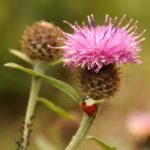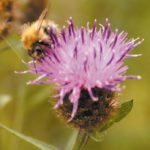The days are getting shorter and the nights are definitely cooler, so you might be forgiven for believing that those last flowers in your wild flower meadow or on your green roof i.e. Clover, Vetch, a few late Red Campion’s, Wild Carrot and Yarrow, Common Knapweed and Scabious, are past their glory and that now everything is looking pretty tatty you could go ahead and cut it all down ready for the winter. Please Don’t!! Consider this:
Although summer is nearing its end, new Bumblebee Queens need to drink lots of nectar to build up body fat in order to survive the winter. Bumblebee species such as the Buff-tailed, Red-tailed and White-tailed are easy to identify and will all be fattening up now. Those last few flowers will still be important to their survival.
Butterflies are now few and far between, with just a few species still in evidence compared with a few weeks ago. Some hibernate through the winter and therefore still need to top up on nectar to get them through the winter. Whilst Painted Lady and Clouded Yellow found feeding on Common Knapweed, Musk Mallow and Vipers Bugloss, need the nectar to build up energy and fat reserves in order to migrate back to Africa, Peacock and Red Admiral are likely to be found grazing too in preparation for hibernation.
Ladybirds are also still at large at this time of the year, and feed voraciously on black flies and green flies found on many wildflowers. They also need to build up fat reserves in order to survive the winter in hibernation.
Our recommendation is to leave your wildflower meadow until at least the autumn is well underway, then to cut it down and remove all the cuttings. By then most of the flowers will have seeded and will make for an even more beautiful meadow next year and the Bumblebees, Butterflies and Ladybirds will also be there to enjoy.

